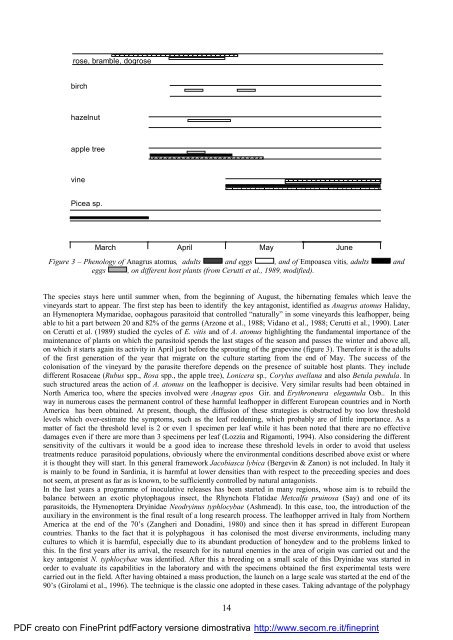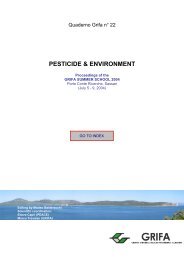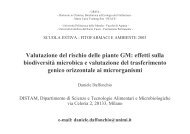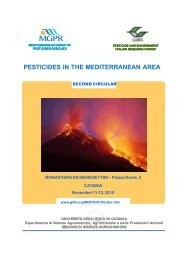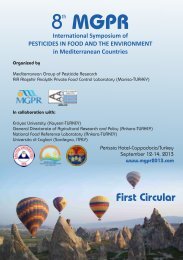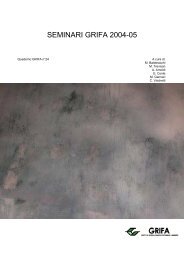International Congress BIOLOGICAL PRODUCTS - Gruppo di ...
International Congress BIOLOGICAL PRODUCTS - Gruppo di ...
International Congress BIOLOGICAL PRODUCTS - Gruppo di ...
Create successful ePaper yourself
Turn your PDF publications into a flip-book with our unique Google optimized e-Paper software.
ose, bramble, dogrose<br />
birch<br />
hazelnut<br />
apple tree<br />
vine<br />
Picea sp.<br />
March April May June<br />
Figure 3 – Phenology of Anagrus atomus, adults and eggs , and of Empoasca vitis, adults and<br />
eggs , on <strong>di</strong>fferent host plants (from Cerutti et al., 1989, mo<strong>di</strong>fied).<br />
The species stays here until summer when, from the beginning of August, the hibernating females which leave the<br />
vineyards start to appear. The first step has been to identify the key antagonist, identified as Anagrus atomus Haliday,<br />
an Hymenoptera Mymaridae, oophagous parasitoid that controlled “naturally” in some vineyards this leafhopper, being<br />
able to hit a part between 20 and 82% of the germs (Arzone et al., 1988; Vidano et al., 1988; Cerutti et al., 1990). Later<br />
on Cerutti et al. (1989) stu<strong>di</strong>ed the cycles of E. vitis and of A. atomus highlighting the fundamental importance of the<br />
maintenance of plants on which the parasitoid spends the last stages of the season and passes the winter and above all,<br />
on which it starts again its activity in April just before the sprouting of the grapevine (figure 3). Therefore it is the adults<br />
of the first generation of the year that migrate on the culture starting from the end of May. The success of the<br />
colonisation of the vineyard by the parasite therefore depends on the presence of suitable host plants. They include<br />
<strong>di</strong>fferent Rosaceae (Rubus spp., Rosa spp., the apple tree), Lonicera sp., Corylus avellana and also Betula pendula. In<br />
such structured areas the action of A. atomus on the leafhopper is decisive. Very similar results had been obtained in<br />
North America too, where the species involved were Anagrus epos Gir. and Erythroneura elegantula Osb.. In this<br />
way in numerous cases the permanent control of these harmful leafhopper in <strong>di</strong>fferent European countries and in North<br />
America has been obtained. At present, though, the <strong>di</strong>ffusion of these strategies is obstructed by too low threshold<br />
levels which over-estimate the symptoms, such as the leaf reddening, which probably are of little importance. As a<br />
matter of fact the threshold level is 2 or even 1 specimen per leaf while it has been noted that there are no effective<br />
damages even if there are more than 3 specimens per leaf (Lozzia and Rigamonti, 1994). Also considering the <strong>di</strong>fferent<br />
sensitivity of the cultivars it would be a good idea to increase these threshold levels in order to avoid that useless<br />
treatments reduce parasitoid populations, obviously where the environmental con<strong>di</strong>tions described above exist or where<br />
it is thought they will start. In this general framework Jacobiasca lybica (Bergevin & Zanon) is not included. In Italy it<br />
is mainly to be found in Sar<strong>di</strong>nia, it is harmful at lower densities than with respect to the precee<strong>di</strong>ng species and does<br />
not seem, at present as far as is known, to be sufficiently controlled by natural antagonists.<br />
In the last years a programme of inoculative releases has been started in many regions, whose aim is to rebuild the<br />
balance between an exotic phytophagous insect, the Rhynchota Flatidae Metcalfa pruinosa (Say) and one of its<br />
parasitoids, the Hymenoptera Dryinidae Neodryinus typhlocybae (Ashmead). In this case, too, the introduction of the<br />
auxiliary in the environment is the final result of a long research process. The leafhopper arrived in Italy from Northern<br />
America at the end of the 70’s (Zangheri and Dona<strong>di</strong>ni, 1980) and since then it has spread in <strong>di</strong>fferent European<br />
countries. Thanks to the fact that it is polyphagous it has colonised the most <strong>di</strong>verse environments, inclu<strong>di</strong>ng many<br />
cultures to which it is harmful, especially due to its abundant production of honeydew and to the problems linked to<br />
this. In the first years after its arrival, the research for its natural enemies in the area of origin was carried out and the<br />
key antagonist N. typhlocybae was identified. After this a bree<strong>di</strong>ng on a small scale of this Dryinidae was started in<br />
order to evaluate its capabilities in the laboratory and with the specimens obtained the first experimental tests were<br />
carried out in the field. After having obtained a mass production, the launch on a large scale was started at the end of the<br />
90’s (Girolami et al., 1996). The technique is the classic one adopted in these cases. Taking advantage of the polyphagy<br />
PDF creato con FinePrint pdfFactory versione <strong>di</strong>mostrativa http://www.secom.re.it/fineprint<br />
14


